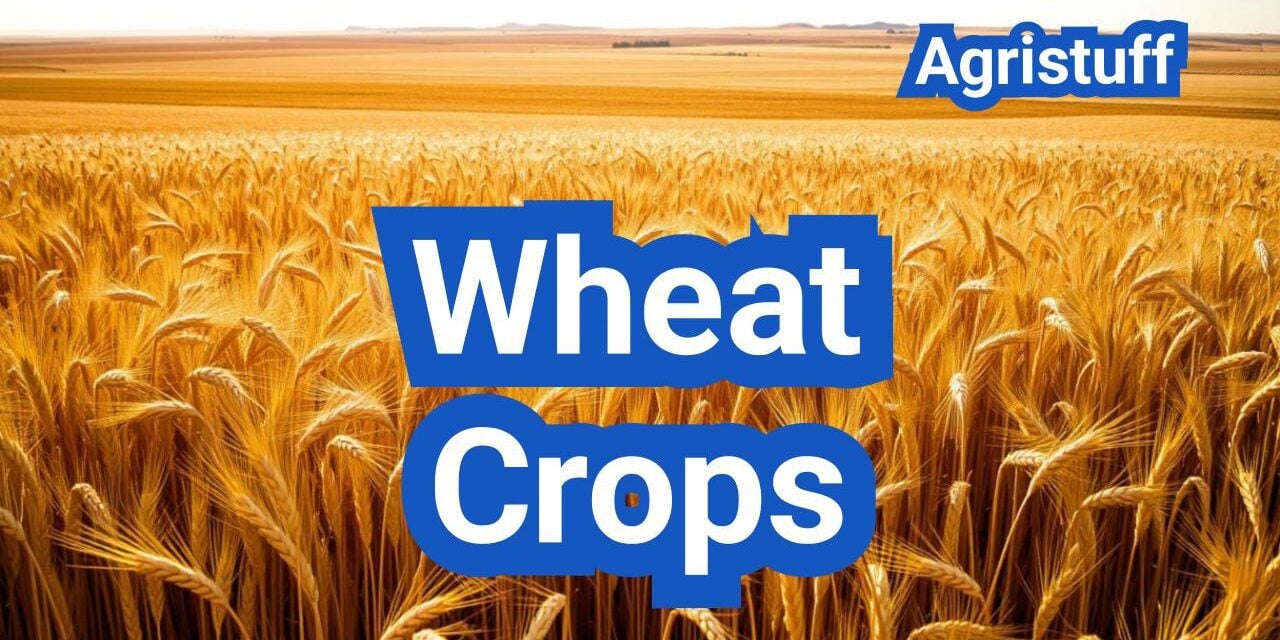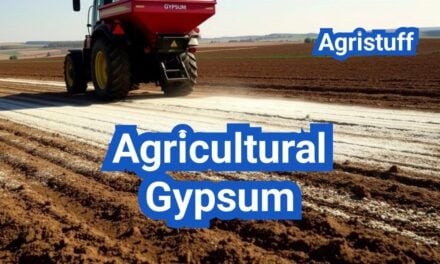Wheat is a staple crop in the United States, playing a vital role in the country’s food supply and economy.
The significance of wheat crops varies across different regions, with each having its unique production practices and challenges.
This article will explore the various aspects of wheat production, including the different varieties, optimal planting rates, and effective disease management strategies across different regions.
Understanding these factors is crucial for farmers, agricultural professionals, and anyone interested in the grain industry.
Key Takeaways
- Understanding regional variations in wheat production practices
- Exploring different wheat varieties and their characteristics
- Optimal planting rates for improved crop yields
- Effective disease management strategies for wheat crops
- The economic importance of wheat as a food source
Overview of Wheat Crops in the United States
U.S. wheat production is a vital sector within American agriculture, influencing regional and national economies. Wheat is one of the most widely grown crops in the United States, with its production affecting not only the agricultural sector but also the broader economy.
Economic Importance of Wheat in U.S. Agriculture
The economic significance of wheat in U.S. agriculture cannot be overstated. It is a major crop that contributes substantially to the national economy through farm income, rural employment, and export earnings. In 2022, the total value of wheat production in the U.S. was approximately $8.4 billion, highlighting its importance as a commodity.
Wheat production supports rural economies by providing jobs and stimulating local economic activity. Moreover, wheat is a critical component in the production of various food products, from bread and baked goods to pasta and cereals, thereby influencing food security and prices.
Major Wheat Production Regions
The United States has diverse wheat production regions, each with its unique characteristics and production challenges. The primary wheat-producing areas include:
- The Great Plains, known for its vast expanses of wheat fields.
- The Midwest, which contributes significantly to soft red winter wheat production.
- The Pacific Northwest, a major producer of soft white wheat.
| Region | Primary Wheat Type | Notable Production Characteristics |
|---|---|---|
| Great Plains | Hard Red Winter Wheat | Large-scale production, dryland farming |
| Midwest | Soft Red Winter Wheat | High rainfall, crop rotation practices |
| Pacific Northwest | Soft White Wheat | Irrigation-based production, high yield potential |
Current Trends in U.S. Wheat Farming
U.S. wheat farming is undergoing significant changes driven by technological advancements, market demands, and environmental considerations. Some of the current trends include:
- Adoption of precision agriculture techniques to improve yield and reduce input costs.
- Increasing focus on sustainability and conservation practices.
- Market shifts influencing the types of wheat grown and production practices.
These trends are shaping the future of wheat production in the United States, with implications for farmers, the environment, and consumers.
Major Classes of U.S. Wheat and Their Uses
U.S. wheat production encompasses several major classes, including hard red winter, hard red spring, soft red winter, and soft white wheat. These classes are distinguished by factors such as protein content, kernel hardness, and growing season, which determine their suitability for various end-products.
Hard Red Winter Wheat
Hard Red Winter (HRW) wheat is the most widely produced class in the United States. It is known for its high protein content and hard kernel texture, making it ideal for bread production. HRW is primarily grown in the Great Plains region, including states like Kansas, Nebraska, and Oklahoma.
Key characteristics:
- High protein content (typically 11-14%)
- Hard kernel texture
- Excellent for bread making due to strong gluten
Hard Red Spring Wheat
Hard Red Spring (HRS) wheat is another important class, known for its very high protein content and strong gluten. It is primarily grown in the northern Great Plains, including North Dakota, Montana, and Minnesota. HRS is used for high-quality bread and specialty bread products.
Key characteristics:
- Very high protein content (typically 14-16%)
- Strong gluten
- Ideal for high-quality bread and specialty products
Soft Red Winter Wheat
Soft Red Winter (SRW) wheat is grown primarily in the eastern United States, including states like Ohio, Michigan, and Illinois. It has a softer kernel and lower protein content compared to hard red wheats, making it suitable for pastries, cakes, and cookies.
Key characteristics:
- Lower protein content (typically 9-11%)
- Soft kernel texture
- Suitable for pastries, cakes, and cookies
Soft White Wheat
Soft White Wheat is grown mainly in the Pacific Northwest, including Washington, Oregon, and Idaho. It has a soft kernel and mild flavor, making it ideal for products like cakes, pastries, and certain types of noodles.
Key characteristics:
- Soft kernel texture
- Mild flavor
- Suitable for cakes, pastries, and specific noodle products
Understanding these major classes of wheat and their uses is crucial for farmers, millers, and bakers to ensure the production of high-quality wheat products that meet consumer demands.
Selecting the Right Wheat Variety for Your Region

The success of your wheat crop depends significantly on selecting a variety that is well-suited to your local climate and soil conditions. This selection process involves considering several critical factors that impact the overall performance and profitability of your wheat crop.
Climate and Soil Compatibility
When choosing a wheat variety, it’s essential to consider the climate and soil type of your region. Different varieties are adapted to different conditions. For instance, some varieties perform better in dry conditions, while others thrive in more moist environments. Soil compatibility is also crucial, as wheat varieties can vary in their tolerance to different soil pH levels and nutrient availability.
Key considerations for climate and soil compatibility include:
- Temperature tolerance
- Moisture requirements
- Soil pH tolerance
- Nutrient use efficiency
Disease Resistance Profiles
Disease resistance is another vital factor in wheat variety selection. Different regions are prone to different diseases, and selecting a variety with resistance to prevalent diseases can significantly reduce the need for fungicides and minimize yield loss. Common wheat diseases include powdery mildew, stripe rust, and fusarium head blight.
The importance of disease resistance cannot be overstated, as it directly impacts yield potential and grain quality.
| Disease | Resistance Level | Impact on Yield |
|---|---|---|
| Powdery Mildew | High | Low |
| Stripe Rust | Moderate | Moderate |
| Fusarium Head Blight | Low | High |
Regional Adaptation Considerations
Regional adaptation is critical for wheat variety selection. Varieties that are well-adapted to a specific region are more likely to perform well under local conditions. This includes adapting to the local climate, soil type, and disease pressures.
Yield Potential vs. Quality Characteristics
There’s often a trade-off between yield potential and quality characteristics in wheat variety selection. High-yielding varieties may not always have the best quality characteristics, and vice versa. The choice depends on the end-use of the wheat and market requirements.
By carefully considering these factors and selecting a wheat variety that is well-suited to your region, you can optimize your wheat production and achieve better yields and quality.
Winter Wheat Management Fundamentals
Effective winter wheat management is crucial for maximizing crop yield and quality. Proper management practices during the fall establishment period significantly impact the overall performance of the crop.
Optimal Planting Windows by Region
Determining the optimal planting window is critical for winter wheat success. The ideal planting time varies by region, depending on factors such as climate, soil type, and moisture availability. In general, planting too early can expose the crop to Hessian fly infestations, while planting too late can result in inadequate establishment before winter.
Hessian Fly-Free Date Importance
The Hessian fly-free date is a crucial consideration for winter wheat planting. This date marks the period after which the risk of Hessian fly infestation decreases significantly. Planting after the Hessian fly-free date can help reduce the need for insecticides and minimize damage to the crop.
Winter Hardiness Considerations
Winter hardiness is a key factor in winter wheat survival. Selecting varieties with good winter hardiness and implementing appropriate management practices, such as proper planting depth and timely fertilization, can enhance the crop’s ability to withstand harsh winter conditions.
Fall Establishment Best Practices
Successful fall establishment is vital for winter wheat productivity. Best practices include preparing a good seedbed, using appropriate seeding rates, and ensuring adequate soil moisture. Additionally, applying stnt.
Spring Wheat Management Strategies
To achieve optimal yields, farmers must employ tailored management strategies for spring wheat. Spring wheat management involves a combination of timely planting, effective moisture conservation, and strategies to mitigate heat stress.
Early Season Planting Techniques
Early season planting is critical for spring wheat. It allows the crop to mature before the onset of hot summer weather. Planting as soon as the soil can be worked in the spring is generally recommended. This approach helps in avoiding late-season drought and heat stress.
Farmers should also consider using cold-tolerant varieties that can withstand potential late-spring frosts. Additionally, preparing the soil properly before planting can improve seedbed conditions and promote uniform emergence.
Moisture Conservation Methods
Conserving moisture is vital for spring wheat, especially in regions prone to dry spells. Techniques such as reduced tillage or no-till farming can help retain soil moisture. These methods reduce soil disturbance, which in turn minimizes evaporation and preserves moisture for the crop.
Another effective strategy is the use of cover crops before planting spring wheat. Cover crops can help capture and retain moisture in the soil, reducing the need for additional irrigation.
Heat Stress Mitigation
Heat stress during the grain-filling stage can significantly reduce spring wheat yields. Irrigation management is one approach to mitigate heat stress. Applying irrigation during critical growth stages can help maintain grain quality and yield.
“Irrigation management is crucial for mitigating heat stress in spring wheat, particularly during the grain-filling stage.”
Additionally, selecting heat-tolerant varieties can provide a genetic buffer against heat stress. These varieties are bred to perform better under high-temperature conditions.
Short-Season Management Approaches
In regions with short growing seasons, managing spring wheat requires careful planning. Choosing varieties with a shorter maturity is essential. These varieties can mature within the available growing season, ensuring a successful harvest.
Farmers in these regions should also focus on optimizing planting dates and using management practices that promote rapid crop establishment and growth.
Wheat Planting Dates by State
Wheat planting dates vary significantly across the United States, influenced by regional climate and soil conditions. Understanding these variations is crucial for farmers to optimize their wheat production.
Northern Plains Region (ND, SD, MT, MN)
In the Northern Plains, which includes North Dakota, South Dakota, Montana, and Minnesota, wheat planting typically occurs in the spring. The optimal planting time is usually around late April to early May, when soil temperatures are suitable for germination.
Spring wheat is the predominant type grown in this region due to the cold winters. Farmers in North Dakota, for instance, usually plant spring wheat around late April, while in Montana, the planting date can be as early as March in some areas.
Central Plains Region (KS, NE, CO)
The Central Plains, comprising Kansas, Nebraska, and Colorado, primarily grow winter wheat. Planting in this region typically occurs in the fall, from September to October. Kansas, being one of the largest wheat-producing states, usually plants winter wheat in late September.
The exact planting date can vary depending on weather conditions and the specific variety of wheat. Nebraska and Colorado also follow a similar planting schedule, with adjustments based on local climate factors.
Southern Plains Region (OK, TX)
In the Southern Plains, which includes Oklahoma and Texas, winter wheat is the dominant crop. Planting dates in this region are generally earlier than in the Central Plains, often starting in late September and continuing through October.
Oklahoma farmers typically plant winter wheat in early October, while in Texas, the planting can start as early as mid-September, depending on the region within the state.
Eastern Region (OH, MI, IN, IL, MO)
The Eastern Region, including Ohio, Michigan, Indiana, Illinois, and Missouri, also grows winter wheat. The planting dates here are generally later than in the Southern Plains, typically occurring from late September to early November.
For example, in Illinois and Indiana, winter wheat is usually planted in late September to early October. Michigan and Ohio follow a similar schedule, with adjustments based on specific weather conditions.
By understanding and adhering to these regional planting dates, farmers across the United States can improve their wheat yields and contribute to the overall success of wheat production in their respective regions.
Optimizing Wheat Seeding Rates

Determining the ideal wheat seeding rate is a critical decision for farmers aiming to improve crop outcomes. Optimizing seeding rates involves several key factors that can significantly impact wheat yield and quality.
Using a Wheat Seeding Rate Calculator
A wheat seeding rate calculator is a valuable tool for farmers to determine the optimal seeding rate for their specific conditions. By inputting factors such as seed size, germination percentage, and production system, farmers can get a more accurate seeding rate. This helps in achieving the desired plant population, which is crucial for maximizing yield potential.
Adjusting for Seed Size (Seeds per Pound)
Seed size varies among different wheat varieties, and this variation affects the number of seeds per pound. Larger seeds mean fewer seeds per pound, while smaller seeds result in more seeds per pound. Adjusting the seeding rate based on seed size ensures that the target number of plants per acre is achieved. For instance, if a variety has larger seeds, the seeding rate should be adjusted downward to avoid over-seeding.
Compensating for Germination Percentage
Germination percentage is another critical factor in determining the optimal seeding rate. Seeds with a lower germination percentage require a higher seeding rate to achieve the desired plant population. Conversely, seeds with a high germination percentage can have a lower seeding rate. Farmers should always check the germination percentage of their seed lot and adjust their seeding rate accordingly.
Seeding Rate Variations by Production System
The production system, whether it’s conventional, no-till, or dual-purpose (grazing and grain), also influences the optimal seeding rate. For example, no-till systems may require higher seeding rates due to potential seedling mortality from soil crusting or pest damage. Dual-purpose systems might need adjusted seeding rates based on the intended use and grazing pressure. Understanding these variations helps farmers tailor their seeding rates to their specific production system.
By considering these factors and using tools like a wheat seeding rate calculator, farmers can optimize their wheat seeding rates. This optimization is key to improving crop establishment, reducing waste, and ultimately enhancing yield and profitability.
Wheat Row Spacing and Planting Depth

The configuration of wheat row spacing and the depth at which wheat is planted significantly influence crop performance and disease management. These factors play a crucial role in determining the overall health and productivity of the wheat crop.
Narrow vs. Wide Row Configurations
Wheat row spacing can vary significantly depending on the region, soil type, and farming practices. Narrow row spacing, typically ranging from 6 to 7.5 inches, is often preferred for its ability to promote quicker canopy closure, reduce soil moisture loss, and increase competitiveness against weeds.
On the other hand, wider row spacing, usually between 12 to 14 inches, may be chosen for its potential to reduce seeding rates and improve air circulation, which can help in managing certain diseases. The choice between narrow and wide row configurations should be based on specific field conditions and management goals.
Optimal Planting Depth by Soil Type
The optimal planting depth for wheat varies by soil type. In general, a planting depth of 1 to 2 inches is recommended for most soils. However, in soils with poor moisture retention, planting slightly deeper can help ensure adequate moisture for germination.
In heavier soils, shallower planting depths may be more appropriate to avoid issues related to excessive moisture. Understanding the specific soil characteristics of your field is crucial for determining the most appropriate planting depth.
Equipment Calibration for Precise Seeding
Equipment calibration is essential for achieving precise seeding rates and depths. Proper calibration ensures that the wheat seeds are planted at the correct depth and spacing, which is vital for uniform emergence and optimal crop performance.
Farmers should regularly check and adjust their planting equipment to account for variations in seed size and other factors that might affect seeding accuracy.
Impact of Row Spacing on Disease Management
Row spacing has a significant impact on disease management in wheat crops. Narrower row spacing can lead to a denser canopy, which may increase the risk of certain diseases due to higher humidity and reduced air circulation.
Conversely, wider row spacing can improve air circulation and reduce the density of the canopy, potentially lowering disease pressure. However, the effect of row spacing on disease management can vary depending on the specific disease and environmental conditions.
Wheat Stand Establishment Tips

A healthy wheat stand is the foundation of successful wheat production. It involves several critical steps that farmers must undertake to ensure optimal yields.
Seedbed Preparation Techniques
Proper seedbed preparation is essential for creating an ideal environment for wheat germination and emergence. This includes tillage practices that remove debris and prepare the soil to the appropriate depth.
The goal is to create a firm, smooth seedbed that allows for uniform seeding depth and good soil-seed contact. Techniques may vary depending on soil type and previous crop residue.
Evaluating Early Season Stand Quality
Assessing early season stand quality is vital for identifying potential issues that could impact yield. Farmers should regularly inspect their fields to evaluate wheat emergence and density.
Factors to consider include uniformity of emergence, plant density, and the presence of any weeds or pests. Early detection of problems allows for timely intervention.
Troubleshooting Poor Emergence
Poor emergence can be caused by various factors, including inadequate seedbed preparation, incorrect seeding depth, and adverse weather conditions.
To troubleshoot, farmers should examine the seedbed for compaction, assess soil moisture levels, and check for signs of pests or diseases. Adjusting practices based on these observations can help improve stand establishment in subsequent seasons.
Early Season Weed Control Strategies
Early season weed control is crucial for preventing weeds from competing with wheat for water, nutrients, and light. Effective strategies include the use of pre-emergence herbicides, cultural practices that promote wheat competitiveness, and mechanical weed control methods.
Farmers should monitor their fields regularly to identify weed species and densities, allowing for targeted control measures that minimize herbicide use and optimize efficacy.
Understanding Feekes Growth Stages for Wheat

Understanding the Feekes growth stages is essential for optimizing wheat production and implementing timely management practices. The Feekes scale is a widely used system that categorizes wheat development into distinct stages, allowing farmers to make informed decisions about crop management.
Vegetative Growth Phases (Feekes 1-5)
The vegetative growth phases, covering Feekes stages 1 to 5, are critical for establishing a strong foundation for the wheat crop. During this period, the crop develops its root system and leaf structure.
- Feekes 1: One leaf through coleoptile.
- Feekes 2: Two leaves unfolded.
- Feekes 3: Three leaves unfolded.
- Feekes 4: “Tillers” or side shoots begin to form.
- Feekes 5: Leaf sheaths strongly erect.
Stem Elongation Stages (Feekes 6-10)
As wheat progresses to the stem elongation stages (Feekes 6-10), the crop begins to develop its stem and prepare for heading.
- Feekes 6: First node visible.
- Feekes 7: Second node visible.
- Feekes 8: Last leaf visible, but still rolled.
- Feekes 9: Ligule (auricle) of last leaf just visible.
- Feekes 10: Boot stage, where the head is still enclosed in the flag leaf sheath.
Reproductive Development Stages (Feekes 10.1-11)
The reproductive development stages, from Feekes 10.1 to 11, are crucial for grain formation and yield.
- Feekes 10.1: Heading, where the wheat head begins to emerge.
- Feekes 10.5: Heading complete.
- Feekes 11: Ripening stage, where the grain matures.
Timing Management Practices to Growth Stages
Timing management practices according to the Feekes growth stages is vital for maximizing yield and quality. Management decisions, such as fertilizer application, pest control, and irrigation, should be based on the specific growth stage of the crop.
By understanding and applying knowledge of the Feekes growth stages, wheat farmers can optimize their management practices, leading to improved crop performance and higher yields.
Strategic Nitrogen Management for Wheat Crops

To enhance wheat production, farmers must adopt a thoughtful approach to nitrogen management. Nitrogen is a critical nutrient for wheat crops, influencing both yield and quality. Effective nitrogen management involves several key strategies, including optimal timing, split applications, appropriate source selection, and the use of tissue testing to guide applications.
Optimal Nitrogen Timing by Growth Stage
The timing of nitrogen application is crucial for maximizing wheat crop performance. Nitrogen uptake varies by growth stage, with significant demand during the vegetative and early reproductive stages.
- Early growth stages (Feekes 1-3): Nitrogen supports leaf development and root establishment.
- Stem elongation (Feekes 6-8): Nitrogen promotes stem growth and tillering.
- Reproductive stages (Feekes 10-11): Nitrogen is essential for grain formation and development.
Applying nitrogen at the right time ensures that the crop has adequate nutrients when needed most, optimizing yield potential.
Split Application Strategies
Split nitrogen application involves dividing the total nitrogen dose into multiple applications across different growth stages. This approach can improve nitrogen use efficiency and reduce losses.
| Application Timing | Nitrogen Rate | Benefits |
|---|---|---|
| Fall (Pre-Plant) | 30-50 lbs/acre | Promotes early growth and root development |
| Spring (Green-up) | 50-70 lbs/acre | Supports tillering and stem elongation |
| At Heading (Feekes 10) | 20-30 lbs/acre | Enhances grain filling and quality |
Nitrogen Source Selection
The choice of nitrogen source can significantly impact wheat crop response and nitrogen use efficiency. Common nitrogen sources include:
- Urea
- Ammonium Nitrate
- UAN (Urea-Ammonium Nitrate) Solution
Each source has its advantages and considerations, including cost, availability, and potential for nitrogen loss.
Using Tissue Testing to Guide Applications
Tissue testing involves analyzing plant tissue to determine nutrient status, helping to guide nitrogen application decisions. This approach can help optimize nitrogen rates and timing, improving crop performance and reducing environmental impact.
By adopting strategic nitrogen management practices, wheat producers can enhance crop yields, improve grain quality, and maintain environmental sustainability.
Fusarium Head Blight Management

Fusarium Head Blight (FHB) is a devastating disease that affects wheat crops worldwide, necessitating effective management strategies. The disease not only reduces yield but also contaminates grain with mycotoxins, such as deoxynivalenol (DON), making it unfit for consumption.
Regional Risk Assessment Tools
Regional risk assessment tools are crucial for predicting FHB outbreaks. These tools typically combine weather data, wheat growth stage information, and disease pressure to forecast the risk of FHB. By utilizing these tools, farmers can make informed decisions about the need for and timing of fungicide applications.
Some of the key factors considered in regional risk assessment include:
- Weather conditions conducive to FHB development, such as high humidity and rainfall during anthesis.
- The susceptibility of the wheat variety being grown.
- The previous crop and its potential to harbor FHB pathogens.
Fungicide Application Timing
The timing of fungicide application is critical for effective FHB management. Fungicides are most effective when applied during anthesis, typically within a few days of the start of flowering. This timing coincides with the period when the wheat crop is most susceptible to FHB infection.
It’s essential to:
- Monitor wheat crops closely to catch the optimal application window.
- Choose fungicides that have been proven effective against FHB.
- Follow label instructions for application rates and timing to maximize efficacy.
Integrated Management Approaches
Integrated management approaches combine cultural, chemical, and genetic controls to manage FHB effectively. Cultural practices include crop rotation and residue management to reduce inoculum potential. Chemical control involves the use of fungicides at the appropriate time. Genetic resistance involves planting wheat varieties that have some level of resistance to FHB.
An integrated approach might include:
- Planting resistant or tolerant varieties.
- Implementing crop rotation to reduce residue.
- Using fungicides judiciously based on risk assessment.
By adopting an integrated management strategy, wheat producers can reduce the impact of FHB on their crops, minimizing yield loss and mycotoxin contamination.
Comprehensive Disease and Pest Management

Wheat crops face numerous challenges from diseases and pests, necessitating comprehensive management strategies. Effective management of these threats is crucial for maintaining healthy crops, maximizing yields, and ensuring quality grain production.
Stripe Rust Control Strategies
Stripe rust, caused by Puccinia striiformis f. sp. tritici, is a significant threat to wheat crops worldwide. Control strategies include:
- Planting resistant varieties
- Applying fungicides at the appropriate growth stage
- Monitoring weather conditions conducive to stripe rust development
Table 1: Fungicide Options for Stripe Rust Control
| Fungicide | Active Ingredient | Efficacy |
|---|---|---|
| Tilt | Propiconazole | High |
| Quilt Xcel | Azoxystrobin + Propiconazole | Very High |
| Priaxor | Fluxapyroxad + Pyraclostrobin | Very High |
Leaf Diseases (Tan Spot, Septoria, Powdery Mildew)
Leaf diseases such as tan spot, Septoria leaf blotch, and powdery mildew can significantly impact wheat yields. Management strategies include:
- Using resistant cultivars
- Implementing crop rotation and sanitation practices
- Applying fungicides based on disease forecasting models
Insect Pest Management
Insect pests like aphids, Hessian fly, and wheat stem sawfly can cause substantial damage to wheat crops. Effective management involves:
- Monitoring fields regularly for pest presence
- Using cultural practices such as delayed planting or adjusted seeding rates
- Applying insecticides when necessary, considering economic thresholds
By integrating these strategies, wheat producers can effectively manage diseases and pests, ensuring healthier crops and better yields.
Dual-Purpose Wheat Grazing Systems
Effective management of dual-purpose wheat is crucial for balancing grazing and grain production. Dual-purpose wheat systems offer farmers the opportunity to generate revenue through both livestock grazing and grain sales.
Variety Selection for Grazing and Grain
Selecting the right wheat variety is critical for successful dual-purpose systems. Farmers should look for varieties that offer a balance between grazing tolerance and grain yield potential. Key characteristics to consider include:
- High forage yield
- Grazing tolerance
- Disease resistance
- Adaptability to local climate conditions
Grazing Management Timeline
A well-planned grazing management timeline is essential to maximize the benefits of dual-purpose wheat. The grazing period typically begins when the wheat is 6-8 inches tall and continues until the onset of jointing or when the wheat reaches the first hollow stem stage.
Balancing Forage and Grain Yield
Balancing forage removal with grain yield is a delicate task. Overgrazing can significantly reduce grain yields, while underutilization can lead to reduced forage quality. A balanced approach involves:
| Management Practice | Impact on Forage Yield | Impact on Grain Yield |
|---|---|---|
| Moderate Grazing | High Forage Yield | Minimal Impact |
| Overgrazing | Reduced Forage Yield | Significant Reduction |
| Underutilization | Reduced Forage Quality | Potential Increase |
Supplemental Nutrition for Grazed Wheat
Providing supplemental nutrition to livestock grazing on dual-purpose wheat can enhance overall system productivity. Nutritional supplements may include:
- Protein supplements
- Energy supplements
- Mineral supplements
By carefully managing dual-purpose wheat systems, farmers can optimize both grazing and grain production, enhancing the overall profitability of their operations.
Keys to Successful Wheat Production
Successful wheat production involves a combination of appropriate variety selection, effective management practices, and timely decision-making. By understanding the major classes of wheat and their uses, farmers can choose the right variety for their region, taking into account factors such as climate, soil compatibility, and disease resistance.
Effective management practices, including optimal planting dates, seeding rates, and nitrogen management, play a crucial role in achieving high yields and quality. Additionally, being aware of potential diseases and pests, such as Fusarium Head Blight and stripe rust, allows farmers to implement integrated management approaches to mitigate risks.
To achieve successful wheat production, farmers should follow best practices for growing wheat, including proper seedbed preparation, early season stand evaluation, and strategic nitrogen application. By integrating these practices and staying informed about regional trends and challenges, wheat producers can optimize their yields and contribute to the overall success of U.S. wheat farming.
FAQ
What are the main classes of wheat grown in the United States?
The main classes of wheat grown in the United States are hard red winter, hard red spring, soft red winter, and soft white wheat. Each class has distinct characteristics and uses.
What is the economic importance of wheat in U.S. agriculture?
Wheat is a significant crop in U.S. agriculture, contributing substantially to the national economy and playing a crucial role in the agricultural sector.
How do I select the right wheat variety for my region?
To select the right wheat variety, consider factors such as climate and soil compatibility, disease resistance profiles, and regional adaptation considerations. It’s also essential to balance yield potential with quality characteristics.
What are the key aspects of winter wheat management?
Key aspects of winter wheat management include planting at the optimal time, adhering to the Hessian fly-free date, enhancing winter hardiness, and implementing best practices for fall establishment.
How can I optimize wheat seeding rates?
Optimizing wheat seeding rates involves using a seeding rate calculator, adjusting for seed size, compensating for germination percentage, and considering variations by production system.
What are the effects of different row spacing configurations on wheat production?
Different row spacing configurations can impact wheat production, including disease management. Narrow and wide row configurations have varying effects, and equipment calibration is crucial for precise seeding.
How do I establish a robust wheat stand?
Establishing a robust wheat stand involves techniques such as seedbed preparation, evaluating early season stand quality, troubleshooting poor emergence, and implementing early season weed control strategies.
What are the Feekes growth stages for wheat?
The Feekes growth stages for wheat cover vegetative growth phases, stem elongation stages, and reproductive development stages. Understanding these stages is essential for timing management practices.
How can I manage Fusarium head blight?
Managing Fusarium head blight involves using regional risk assessment tools, optimal fungicide application timing, and integrated management approaches that combine cultural, chemical, and genetic controls.
What are the principles of strategic nitrogen management for wheat?
Strategic nitrogen management for wheat involves determining optimal nitrogen timing based on growth stages, using split application strategies, selecting appropriate nitrogen sources, and utilizing tissue testing to guide applications.
How can I manage dual-purpose wheat systems?
Managing dual-purpose wheat systems involves selecting suitable varieties, implementing grazing management timelines, balancing forage and grain yields, and providing supplemental nutrition for grazed wheat.
What are the most common diseases affecting wheat crops?
Common diseases affecting wheat crops include stripe rust, leaf diseases such as tan spot, Septoria, and powdery mildew, and Fusarium head blight.
How can I control stripe rust in wheat?
Controlling stripe rust involves using resistant varieties, applying fungicides at the optimal time, and implementing cultural practices that reduce disease pressure.
What is the importance of wheat seeding rate?
The wheat seeding rate is crucial as it affects crop yield and quality. Optimizing the seeding rate helps achieve the desired plant population, reducing competition and promoting healthy growth.
What are the benefits of using a wheat seeding rate calculator?
A wheat seeding rate calculator helps determine the optimal seeding rate based on factors such as seed size, germination percentage, and production system, ensuring the most efficient use of seeds.
Conclusion of: Wheat Crops
Why wheat crops still matter in the U.S.
Wheat crops underpin food and feed security in the U.S., but top performance depends on matching class, variety, and management to regional conditions and markets—bread, crackers, noodles, or durum semolina all start with the right agronomy for wheat crops. USDA ERS: Wheat sector overview
Know your classes before you plant wheat crops
Choosing among Hard Red Winter, Hard Red Spring, Soft Red Winter, Soft White, Hard White, and Durum determines end-use quality and guides agronomy; aligning class to climate is the first step to profitable wheat crops. U.S. Wheat Associates: Classes of wheat
Winter vs. spring growth habit in wheat crops
Winter types of wheat crops (e.g., SRW, HRW, many Soft White) require fall planting and vernalization, while spring types (e.g., HRS, some durum) are planted as soils warm; choosing habit that suits your frost dates and residue is pivotal for wheat crops. USDA AMS: Wheat standards & classes
Regional map for wheat crops: where each class dominates
Broadly, wheat crops break out as HRW in the Central and Southern Great Plains, HRS and durum in the Northern Plains, SRW in the Midwest/East, Soft White in the Pacific Northwest, and Desert Durum® in irrigated Arizona/California; this geography frames your management of wheat crops. Kansas Wheat: Class-by-region primer
Planting windows for HRW wheat crops (Great Plains)
For HRW wheat crops in Kansas and neighbors, plant within the state’s recommended fall windows to balance tiller formation and winter survival; too early elevates pest/disease risk, too late risks winter injury and thin stands in wheat crops. K-State Agronomy eUpdate: Wheat planting timing
Planting windows for SRW wheat crops (Midwest/East)
In SRW regions, the 7–14 days after the county Hessian fly–safe date is typically ideal; if soybean harvest pushes you later, increase seeding rates to offset fewer fall tillers in wheat crops. Ohio State Extension: Wheat management hub
Planting windows for HRS wheat crops (Northern Plains)
For HRS wheat crops, early spring planting as soon as soils are fit maximizes yield and protein; seeding into cool soils speeds canopy closure and helps the crop outcompete weeds in wheat crops. SDSU Extension: Wheat production guide
Planting windows for Soft White & spring wheat crops (PNW)
In the PNW’s diverse rainfall zones, fall-seeded Soft White and spring-seeded HRS require timing by soil temperature and moisture; calibrate depth and firm seedbeds for uniform emergence in wheat crops. WSU Wheat & Small Grains: Regional resources
Planting windows for Desert Durum® wheat crops (AZ/CA)
Under irrigation, Desert Durum® wheat crops are often planted December–February and harvested May–June to hit early milling windows with naturally low grain moisture from arid conditions in wheat crops. U.S. Wheat Associates: Desert Durum®
Seeds per acre—not pounds—drives wheat crops seeding accuracy
Seed size varies widely, so convert bag weight to seeds per acre to target the right plant density for wheat crops; use your seed tag’s seeds/lb and germination to dial rates precisely in wheat crops. WSU: Seed Rate Calculator
Recommended HRW seeding rates for wheat crops (Great Plains)
Typical starting points for HRW wheat crops are ~900,000–1,200,000 seeds/acre in central/western Plains and up to ~1,350,000 seeds/acre farther east; raise rates for late planting or no-till residue that limits fall tillering in wheat crops. K-State MF991: Kansas Wheat Variety Guide (rates & agronomics)
Recommended SRW seeding rates for wheat crops (Midwest/East)
On-time SRW wheat crops often target ~1.0–1.2 million seeds/acre, but delayed planting after fly-safe dates merits higher rates to compensate for fewer fall tillers and ensure uniform stands in wheat crops. Purdue AY-315: Small grains management
Recommended HRS seeding rates for wheat crops (Northern Plains)
For HRS wheat crops, many land-grant programs recommend ~1.2–1.4 million seeds/acre and 1.5–2.0 inch depth, adjusted for soil moisture and variety coleoptile length in wheat crops. NDSU Extension: Hard Red Spring Wheat
Seeding rates by rainfall zone for PNW wheat crops
In low-rainfall areas, winter wheat crops may run nearer ~18–22 plants/ft², with higher targets under irrigation or higher rainfall; calibrate drills whenever seed size shifts to protect stand uniformity in wheat crops. WSU: Establishment & seeding tools
Irrigated wheat crops in the desert: rate conversions
Arizona guidance often lists lb/acre starting points for wheat and durum; always convert to seeds/acre using tag data so irrigated wheat crops hit consistent plant populations for yield and quality. Univ. of Arizona: Seeding rates for small grains
Seeding depth and row spacing for wheat crops
Most winter wheat crops emerge best from ~1–2 inches, with shallower depth for small-seeded lots and heavier clays; 7.5–10 inch rows are common, with narrower spacing helping late-planted or irrigated wheat crops close canopy sooner. UNL CropWatch: Wheat establishment
Fertility strategy for wheat crops (N, P, K, S)
Soil tests set P, K, and S; many programs place modest fall N (e.g., 20–30 lb N/ac) for winter wheat crops, then topdress the remainder ahead of rapid spring growth to protect protein and avoid lodging in wheat crops. Purdue: Small grains fertility (AY-315-W)
Variety selection: disease and standability for wheat crops
Lean on current state variety guides to balance yield, test weight, straw strength, and resistance packages (FHB, leaf rust, stripe rust) so wheat crops withstand weather and disease pressure while meeting buyer specs. K-State: Variety ratings & notes
Variety data for HRS wheat crops (Northern Plains)
In HRS regions, multi-location trials reveal protein potential and tolerance to FHB and leaf spot complex; pick stable performers so wheat crops hit grade and protein targets consistently. NDSU: HRS variety results
Variety testing for SRW wheat crops (Midwest/East)
In humid SRW zones, prioritize scab tolerance and test weight history; variety trials help wheat crops reduce DON risk while sustaining milling quality across environments. University of Kentucky: Wheat variety testing
Top foliar disease threats to wheat crops: stripe rust
Stripe rust can explode in cool, moist springs—especially in the PNW—so choose resistant genetics, destroy volunteer wheat, and only apply fungicide when thresholds and forecasts justify it to protect wheat crops. WSU: Stripe rust resource center
Fusarium head blight (scab) in wheat crops (Midwest/East)
Use moderately resistant varieties, rotate away from corn residue, and apply a triazole at early flowering when risk tools flag danger to keep DON low and quality high in wheat crops. FHB Prediction Center (Penn State)
Leaf rust and blotches in wheat crops (Plains/Midwest)
Leaf rust plus Septoria/Stagonospora reduce green leaf area and grain fill; scout upper canopy near heading and spray only if disease threatens yield so wheat crops retain flag leaf function. Crop Protection Network: Leaf rust
Disease-smart planting for wheat crops: seed treatments & timing
Early fall planting and volunteer “green bridges” raise risk of BYDV and fall foliar diseases; align dates and consider labeled fungicide/insecticide seed treatments where pressure/history justifies them for wheat crops. OSU Extension: Planting date & seed treatment
Fungicide efficacy & resistance stewardship for wheat crops
When disease pressure warrants, select proven actives and rotate FRAC groups; annual university efficacy tables help you spend wisely and protect chemistry for future wheat crops. Crop Protection Network: Wheat fungicide efficacy
Dual-purpose wheat crops (forage + grain) in the Southern Plains
For grazing plus grain, earlier planting and higher seeding rates are common, but pull cattle at first hollow stem to safeguard heads per square foot and yield in wheat crops. OSU Extension: Dual-purpose wheat
Weed management foundations for wheat crops
Start clean with burndown or tillage as appropriate, rotate herbicide modes of action, and maintain crop competition with timely planting and adequate fertility so wheat crops suppress weeds naturally. University of Minnesota Extension: Small grains weed management
Insect management in wheat crops: aphids & BYDV
Aphids vector BYDV; managing planting date, removing volunteer wheat, and targeted insecticide only when thresholds are exceeded helps wheat crops avoid needless sprays and yield loss. OSU: Barley yellow dwarf in wheat
Irrigation, water, and heat stress in wheat crops
Under irrigation, avoid excessive late N that delays maturity, and schedule water to protect boot-to-milk stages; drought/heat-tolerant genetics and residue retention help wheat crops in semi-arid systems. Utah State University: Wheat irrigation & N
Fertility fine-tuning for protein in wheat crops
Split N and consider late-season applications on strong yield potential fields to hit protein specs; tissue testing and in-season sensors can guide responsive feeding of wheat crops. Montana State University: Nitrogen for wheat
Harvest timing and grain quality for wheat crops
Harvest when grain moisture is appropriate for your market and weather risk; timely harvest protects test weight and reduces late disease exposure so wheat crops meet buyer standards. NDSU Extension: Pre-harvest management
Post-harvest handling and storage for wheat crops
Cool grain quickly, manage aeration, and monitor for insects and moisture migration to keep wheat crops safe in storage and prevent quality losses or mycotoxin issues. K-State: Grain storage & management
Marketing signals and protein premiums for wheat crops
Know your elevator’s test weight and protein scales and whether identity-preserved channels exist for your class; aligning agronomy with market specs helps wheat crops capture premiums. USDA FGIS: Grain grading standards
Record-keeping and on-farm trials for wheat crops
Compare varieties, rates, and fungicide timings with simple strip tests and keep clean records; localized data makes next year’s wheat crops more resilient and profitable. University of Missouri Extension: On-farm testing guide
Learning the growth stages to time inputs for wheat crops
Using Feekes or Zadoks scales ensures you time nitrogen, herbicides, and fungicides precisely; understanding growth stages protects yield while limiting waste in wheat crops. Penn State Extension: Wheat growth stages
Final thought
High-performing wheat crops come from getting the big three right—variety selection by region, precise seeds-per-acre and planting windows, and disease management tied to real-time risk—then fine-tuning fertility, irrigation, and harvest to match quality specs so wheat crops pay. Crop Protection Network: Wheat disease loss estimates
Sources & References
These authoritative resources inform agronomic decisions for wheat crops across U.S. regions.
- USDA ERS: Wheat sector
- U.S. Wheat Associates: Classes of wheat
- K-State Agronomy eUpdate (wheat)
- K-State MF991: Kansas Wheat Variety Guide
- Ohio State Extension: Wheat
- WSU Wheat & Small Grains
- U.S. Wheat Associates: Desert Durum®
- WSU: Seed rate calculator
- UNL CropWatch: Wheat
- WSU: Stripe rust
- FHB Prediction Center
- CPN: Leaf rust
- CPN: Fungicide efficacy
- CPN: Wheat disease loss estimates










